Motorola LS4208 User Manual
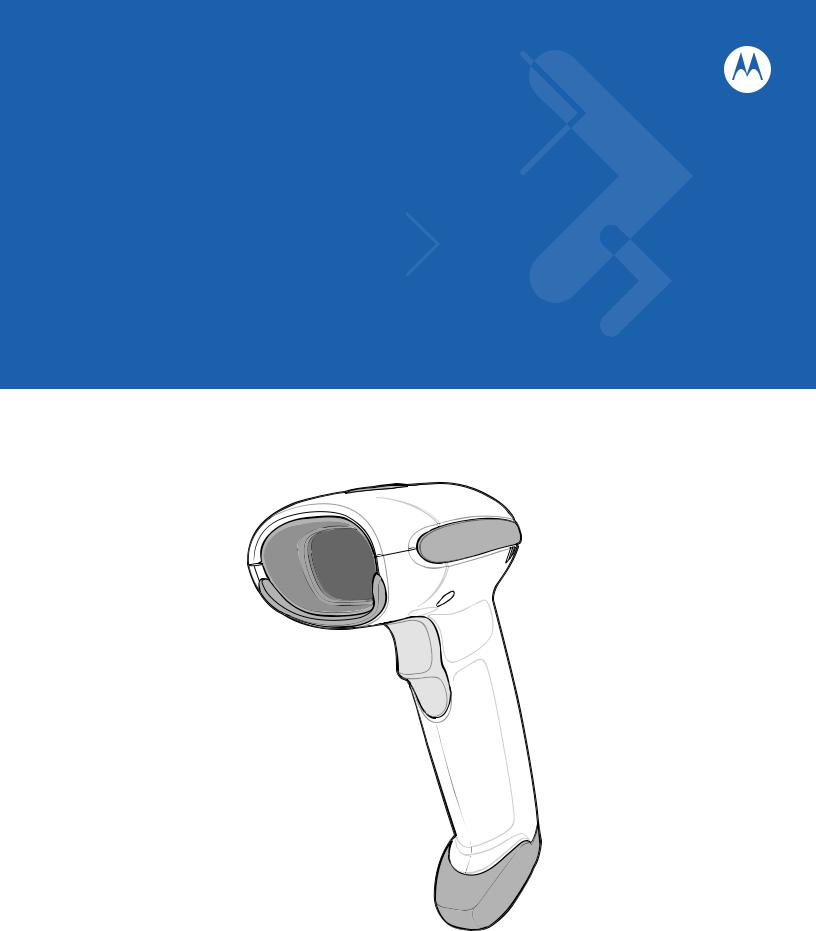
Symbol LS4208
Product Reference Guide
Symbol LS4208
Product Reference Guide
72E-69413-07
Revision A
November 2012

ii Symbol LS4208 Product Reference Guide
© 2009-2012 Motorola Solutions, Inc. All rights reserved.
No part of this publication may be reproduced or used in any form, or by any electrical or mechanical means, without permission in writing from Motorola. This includes electronic or mechanical means, such as photocopying, recording, or information storage and retrieval systems. The material in this manual is subject to change without notice.
The software is provided strictly on an “as is” basis. All software, including firmware, furnished to the user is on a licensed basis. Motorola grants to the user a non-transferable and non-exclusive license to use each software or firmware program delivered hereunder (licensed program). Except as noted below, such license may not be assigned, sublicensed, or otherwise transferred by the user without prior written consent of Motorola. No right to copy a licensed program in whole or in part is granted, except as permitted under copyright law. The user shall not modify, merge, or incorporate any form or portion of a licensed program with other program material, create a derivative work from a licensed program, or use a licensed program in a network without written permission from Motorola. The user agrees to maintain Motorola’s copyright notice on the licensed programs delivered hereunder, and to include the same on any authorized copies it makes, in whole or in part. The user agrees not to decompile, disassemble, decode, or reverse engineer any licensed program delivered to the user or any portion thereof.
Motorola reserves the right to make changes to any software or product to improve reliability, function, or design.
Motorola does not assume any product liability arising out of, or in connection with, the application or use of any product, circuit, or application described herein.
No license is granted, either expressly or by implication, estoppel, or otherwise under any Motorola, Inc., intellectual property rights. An implied license only exists for equipment, circuits, and subsystems contained in Motorola products.
MOTOROLA, MOTO, MOTOROLA SOLUTIONS and the Stylized M Logo are trademarks or registered trademarks of Motorola Trademark Holdings, LLC and are used under license. All other trademarks are the property of their respective owners.
Motorola Solutions, Inc.
One Motorola Plaza
Holtsville, New York 11742-1300
http://www.motorolasolutions.com
Warranty
For the complete Motorola hardware product warranty statement, go to:
http://www.motorola.com/enterprisemobility/warranty.

iii
Revision History
Changes to the original manual are listed below:
Change |
Date |
Description |
|
|
|
-01 Rev A |
5/2005 |
Initial release. |
|
|
|
-02 Rev A |
6/2005 |
Update RSS description. |
|
|
|
-03 Rev A |
1/2007 |
Update service section, add special IBM command bar codes, add parameter bar |
|
|
codes for Bookland ISBN format and new UPC supplemental decode options, add |
|
|
bar codes for report version, report MIMIC version, and report Synapse cable, add |
|
|
ADF section. |
|
|
|
-04 Rev A |
6/2007 |
Add information for LS4208PR version, which supports PDF417. |
|
|
|
-05 Rev A |
7/2007 |
Add note to end of Wand Emulation chapter regarding error beep emitted when |
|
|
scanner attempts to send composite data. |
|
|
|
-06 Rev A |
4/2009 |
Add Parameter Scanning option, add Simple COM Port Emulation to USB device |
|
|
type parameter, add new ADF options. |
|
|
|
-07 Rev A |
11/2012 |
Removed patents, and Regulatory specs; updated URLs, ambient light tolerance, |
|
|
and 123Scan2 chapter. |

iv Symbol LS4208 Product Reference Guide

Table of Contents
Warranty ........................................................................................................................ |
ii |
Revision History............................................................................................................. |
iii |
About This Guide |
|
Introduction .................................................................................................................... |
xiii |
Notational Conventions.................................................................................................. |
xiv |
Related Documents ....................................................................................................... |
xiv |
Service Information........................................................................................................ |
xv |
Chapter 1: Getting Started |
|
Introduction ................................................................................................................... |
1-1 |
Unpacking ..................................................................................................................... |
1-2 |
Setting Up the Scanner ................................................................................................. |
1-3 |
Installing the Interface Cable .................................................................................. |
1-3 |
Removing the Interface Cable ................................................................................ |
1-4 |
Connecting a Synapse Cable Interface .................................................................. |
1-4 |
Connecting Power (if required) ............................................................................... |
1-4 |
Configuring the Scanner ......................................................................................... |
1-5 |
Chapter 2: Scanning |
|
Introduction ................................................................................................................... |
2-1 |
Beeper Definitions ........................................................................................................ |
2-2 |
LED Definitions ............................................................................................................. |
2-3 |
Scan Patterns ............................................................................................................... |
2-4 |
Single-Line Only ...................................................................................................... |
2-4 |
Multi-Line Smart Raster .......................................................................................... |
2-4 |
Multi-line Always Raster .......................................................................................... |
2-4 |
Scanning Modes ........................................................................................................... |
2-5 |
Scanning in Hand-Held Mode ................................................................................. |
2-5 |
Scanning in Hands-Free Mode ............................................................................... |
2-9 |
Symbol LS4208 Decode Zone ...................................................................................... |
2-11 |

vi Symbol LS4208 Product Reference Guide
Chapter 3: Maintenance, Troubleshooting & Technical Specifications |
|
Introduction ................................................................................................................... |
3-1 |
Maintenance ................................................................................................................. |
3-1 |
Troubleshooting ............................................................................................................ |
3-2 |
Technical Specifications ............................................................................................... |
3-5 |
Scanner Signal Descriptions ......................................................................................... |
3-7 |
Chapter 4: User Preferences |
|
Introduction ................................................................................................................... |
4-1 |
Scanning Sequence Examples ..................................................................................... |
4-1 |
Errors While Scanning .................................................................................................. |
4-1 |
User Preferences Parameter Defaults .......................................................................... |
4-2 |
User Preferences .......................................................................................................... |
4-3 |
Default Parameters ................................................................................................. |
4-3 |
Parameter Bar Code Scanning ............................................................................... |
4-4 |
Beeper Tone ........................................................................................................... |
4-4 |
Beeper Volume ....................................................................................................... |
4-5 |
Power Mode ............................................................................................................ |
4-5 |
Scan Pattern ........................................................................................................... |
4-6 |
Scan Line Width ...................................................................................................... |
4-7 |
Raster Height .......................................................................................................... |
4-8 |
Laser On Time ........................................................................................................ |
4-9 |
Beep After Good Decode ........................................................................................ |
4-9 |
PDF Decode Feedback ........................................................................................... |
4-10 |
Chapter 5: Keyboard Wedge Interface |
|
Introduction ................................................................................................................... |
5-1 |
Connecting a Keyboard Wedge Interface ..................................................................... |
5-2 |
Keyboard Wedge Parameter Defaults .......................................................................... |
5-3 |
Keyboard Wedge Host Parameters .............................................................................. |
5-4 |
Keyboard Wedge Host Types ................................................................................. |
5-4 |
Keyboard Wedge Country Types (Country Codes) ................................................ |
5-5 |
Ignore Unknown Characters ................................................................................... |
5-6 |
Keystroke Delay ...................................................................................................... |
5-7 |
Intra-Keystroke Delay ............................................................................................. |
5-7 |
Alternate Numeric Keypad Emulation ..................................................................... |
5-8 |
Caps Lock On ......................................................................................................... |
5-8 |
Caps Lock Override ................................................................................................ |
5-9 |
Convert Wedge Data .............................................................................................. |
5-10 |
Function Key Mapping ............................................................................................ |
5-10 |
FN1 Substitution ..................................................................................................... |
5-11 |
Send Make and Break ............................................................................................ |
5-11 |
Keyboard Maps ....................................................................................................... |
5-12 |
ASCII Character Set for Keyboard Wedge ................................................................... |
5-13 |
Table of Contents |
vii |
|
|
Chapter 6: RS-232 Interface |
|
Introduction ................................................................................................................... |
6-1 |
Connecting an RS-232 Interface .................................................................................. |
6-2 |
RS-232 Parameter Defaults .......................................................................................... |
6-3 |
RS-232 Host Parameters .............................................................................................. |
6-4 |
RS-232 Host Types ................................................................................................. |
6-6 |
Baud Rate ............................................................................................................... |
6-7 |
Parity ....................................................................................................................... |
6-8 |
Stop Bit Select ........................................................................................................ |
6-9 |
Data Bits (ASCII Format) ........................................................................................ |
6-9 |
Check Receive Errors ............................................................................................. |
6-10 |
Hardware Handshaking .......................................................................................... |
6-10 |
Software Handshaking ............................................................................................ |
6-12 |
Host Serial Response Time-out .............................................................................. |
6-14 |
RTS Line State ........................................................................................................ |
6-15 |
Beep on <BEL> ....................................................................................................... |
6-15 |
Intercharacter Delay ................................................................................................ |
6-16 |
Nixdorf Beep/LED Options ...................................................................................... |
6-17 |
Ignore Unknown Characters ................................................................................... |
6-17 |
ASCII Character Set for RS-232 ................................................................................... |
6-18 |
Chapter 7: USB Interface |
|
Introduction ................................................................................................................... |
7-1 |
Connecting a USB Interface ......................................................................................... |
7-2 |
USB Parameter Defaults .............................................................................................. |
7-4 |
USB Host Parameters .................................................................................................. |
7-5 |
USB Device Type .................................................................................................... |
7-5 |
USB Country Keyboard Types (Country Codes) .................................................... |
7-6 |
USB Keystroke Delay ............................................................................................. |
7-8 |
USB CAPS Lock Override ...................................................................................... |
7-8 |
USB Ignore Unknown Characters ........................................................................... |
7-9 |
Emulate Keypad ...................................................................................................... |
7-9 |
USB Keyboard FN 1 Substitution ............................................................................ |
7-10 |
Function Key Mapping ............................................................................................ |
7-10 |
Simulated Caps Lock .............................................................................................. |
7-11 |
Convert Case .......................................................................................................... |
7-11 |
ASCII Character Set for USB ........................................................................................ |
7-12 |
Chapter 8: IBM Interface |
|
Introduction ................................................................................................................... |
8-1 |
Connecting to an IBM 468X/469X Host ........................................................................ |
8-2 |
IBM Parameter Defaults ............................................................................................... |
8-3 |
IBM 468X/469X Host Parameters ................................................................................. |
8-4 |
Port Address ........................................................................................................... |
8-4 |
Convert Unknown to Code 39 ................................................................................. |
8-5 |
Optional IBM Parameters ............................................................................................. |
8-6 |
Ignore Beep ............................................................................................................ |
8-6 |
Ignore Bar Code Configuration ............................................................................... |
8-6 |

viii Symbol LS4208 Product Reference Guide
Chapter 9: Wand Emulation Interface |
|
Introduction ................................................................................................................... |
9-1 |
Connecting Using Wand Emulation .............................................................................. |
9-2 |
Wand Emulation Parameter Defaults ........................................................................... |
9-3 |
Wand Emulation Host Parameters ............................................................................... |
9-4 |
Wand Emulation Host Types .................................................................................. |
9-4 |
Leading Margin (Quiet Zone) .................................................................................. |
9-5 |
Polarity .................................................................................................................... |
9-6 |
Ignore Unknown Characters ................................................................................... |
9-6 |
Convert All Bar Codes to Code 39 .......................................................................... |
9-7 |
Convert Code 39 to Full ASCII ............................................................................... |
9-8 |
Chapter 10: Scanner Emulation Interface |
|
Introduction ................................................................................................................... |
10-1 |
Connecting Using Scanner Emulation .......................................................................... |
10-2 |
Scanner Emulation Parameter Defaults ....................................................................... |
10-3 |
Scanner Emulation Host ............................................................................................... |
10-4 |
Scanner Emulation Host Parameters ........................................................................... |
10-4 |
Beep Style ............................................................................................................... |
10-4 |
Parameter Pass-Through ........................................................................................ |
10-5 |
Convert Newer Code Types .................................................................................... |
10-6 |
Module Width .......................................................................................................... |
10-7 |
Convert All Bar Codes to Code 39 .......................................................................... |
10-7 |
Code 39 Full ASCII Conversion .............................................................................. |
10-8 |
Transmission Timeout ............................................................................................. |
10-9 |
Ignore Unknown Characters ................................................................................... |
10-10 |
Leading Margin ....................................................................................................... |
10-10 |
Check For Decode LED .......................................................................................... |
10-11 |
Chapter 11: 123Scan |
|
Introduction ................................................................................................................... |
11-1 |
Communication with 123Scan2 .................................................................................... |
11-1 |
123Scan2 Requirements .............................................................................................. |
11-2 |
Chapter 12: Symbologies |
|
Introduction ................................................................................................................... |
12-1 |
Scanning Sequence Examples ..................................................................................... |
12-1 |
Errors While Scanning .................................................................................................. |
12-2 |
Symbology Parameter Defaults .................................................................................... |
12-2 |
UPC/EAN ...................................................................................................................... |
12-6 |
Enable/Disable UPC-A/UPC-E ............................................................................... |
12-6 |
Enable/Disable UPC-E1 .......................................................................................... |
12-7 |
Enable/Disable EAN-13/EAN-8 ............................................................................... |
12-8 |
Enable/Disable Bookland EAN ............................................................................... |
12-9 |
Decode UPC/EAN/JAN Supplementals .................................................................. |
12-9 |
UPC/EAN/JAN Supplemental Redundancy ............................................................ |
12-14 |
Transmit UPC-A Check Digit .................................................................................. |
12-14 |
Table of Contents |
ix |
|
|
Transmit UPC-E Check Digit .................................................................................. |
12-15 |
Transmit UPC-E1 Check Digit ................................................................................ |
12-15 |
UPC-A Preamble .................................................................................................... |
12-16 |
UPC-E Preamble .................................................................................................... |
12-17 |
UPC-E1 Preamble .................................................................................................. |
12-18 |
Convert UPC-E to UPC-A ....................................................................................... |
12-19 |
Convert UPC-E1 to UPC-A ..................................................................................... |
12-19 |
EAN-8/JAN-8 Extend .............................................................................................. |
12-20 |
Bookland ISBN Format ........................................................................................... |
12-21 |
UCC Coupon Extended Code ................................................................................. |
12-22 |
Code 128 ...................................................................................................................... |
12-23 |
Enable/Disable Code 128 ....................................................................................... |
12-23 |
Enable/Disable GS1-128 (formerly UCC/EAN-128) ................................................ |
12-23 |
Enable/Disable ISBT 128 ........................................................................................ |
12-24 |
Code 39 ........................................................................................................................ |
12-25 |
Enable/Disable Code 39 ......................................................................................... |
12-25 |
Enable/Disable Trioptic Code 39 ............................................................................ |
12-25 |
Convert Code 39 to Code 32 .................................................................................. |
12-26 |
Code 32 Prefix ........................................................................................................ |
12-26 |
Set Lengths for Code 39 ......................................................................................... |
12-27 |
Code 39 Check Digit Verification ............................................................................ |
12-28 |
Transmit Code 39 Check Digit ................................................................................ |
12-29 |
Code 39 Full ASCII Conversion .............................................................................. |
12-30 |
Code 39 Buffering (Scan & Store) .......................................................................... |
12-31 |
Code 93 ........................................................................................................................ |
12-34 |
Enable/Disable Code 93 ......................................................................................... |
12-34 |
Set Lengths for Code 93 ......................................................................................... |
12-34 |
Code 11 ........................................................................................................................ |
12-36 |
Code 11 .................................................................................................................. |
12-36 |
Set Lengths for Code 11 ......................................................................................... |
12-36 |
Code 11 Check Digit Verification ............................................................................ |
12-38 |
Transmit Code 11 Check Digits .............................................................................. |
12-39 |
Interleaved 2 of 5 (ITF) ................................................................................................. |
12-40 |
Enable/Disable Interleaved 2 of 5 ........................................................................... |
12-40 |
Set Lengths for Interleaved 2 of 5 ........................................................................... |
12-40 |
I 2 of 5 Check Digit Verification ............................................................................... |
12-42 |
Transmit I 2 of 5 Check Digit ................................................................................... |
12-43 |
Convert I 2 of 5 to EAN-13 ...................................................................................... |
12-43 |
Discrete 2 of 5 (DTF) .................................................................................................... |
12-44 |
Enable/Disable Discrete 2 of 5 ................................................................................ |
12-44 |
Set Lengths for Discrete 2 of 5 ............................................................................... |
12-44 |
Chinese 2 of 5 ............................................................................................................... |
12-46 |
Enable/Disable Chinese 2 of 5 ................................................................................ |
12-46 |
Codabar (NW - 7) ......................................................................................................... |
12-47 |
Enable/Disable Codabar ......................................................................................... |
12-47 |
Set Lengths for Codabar ......................................................................................... |
12-47 |
CLSI Editing ............................................................................................................ |
12-49 |
NOTIS Editing ......................................................................................................... |
12-49 |
MSI ............................................................................................................................... |
12-50 |
Enable/Disable MSI ................................................................................................ |
12-50 |

x Symbol LS4208 Product Reference Guide
Set Lengths for MSI ................................................................................................ |
12-50 |
MSI Check Digits .................................................................................................... |
12-51 |
Transmit MSI Check Digit(s) ................................................................................... |
12-52 |
MSI Check Digit Algorithm ...................................................................................... |
12-52 |
GS1 DataBar (formerly RSS - Reduced Space Symbology) ........................................ |
12-53 |
Convert GS1 DataBar to UPC/EAN ........................................................................ |
12-54 |
PDF417/MicroPDF417 .................................................................................................. |
12-55 |
Enable/Disable PDF417 .......................................................................................... |
12-55 |
Enable/Disable MicroPDF417 ................................................................................. |
12-55 |
MicroPDF Performance .......................................................................................... |
12-56 |
Transmit Symbols in Codeword Format .................................................................. |
12-57 |
Transmit Unknown Codewords ............................................................................... |
12-58 |
Escape Characters ................................................................................................. |
12-58 |
Delete Character Set ECIs ...................................................................................... |
12-59 |
Composite Codes ......................................................................................................... |
12-60 |
Composite CC-C ..................................................................................................... |
12-60 |
Composite CC-A/B .................................................................................................. |
12-60 |
UPC Composite Mode ............................................................................................ |
12-61 |
Composite Beep Mode ........................................................................................... |
12-62 |
Symbology - Specific Security Levels ........................................................................... |
12-63 |
Redundancy Level .................................................................................................. |
12-63 |
Security Level ......................................................................................................... |
12-65 |
Bi-directional Redunda\ncy ..................................................................................... |
12-66 |
Intercharacter Gap ........................................................................................................ |
12-66 |
Chapter 13: Miscellaneous Scanner Options |
|
Introduction ................................................................................................................... |
13-1 |
Scanning Sequence Examples ..................................................................................... |
13-1 |
Errors While Scanning .................................................................................................. |
13-1 |
Miscellaneous Parameter Defaults ............................................................................... |
13-2 |
Miscellaneous Scanner Parameters ............................................................................. |
13-3 |
Transmit Code ID Character ................................................................................... |
13-3 |
Prefix/Suffix Values ................................................................................................. |
13-3 |
Scan Data Transmission Format ............................................................................ |
13-4 |
FN1 Substitution Values ......................................................................................... |
13-6 |
Transmit “No Read” Message ................................................................................. |
13-6 |
Synapse Interface ................................................................................................... |
13-7 |
Report Version ........................................................................................................ |
13-8 |
Report Synapse Cable ............................................................................................ |
13-8 |
Chapter 14: Advanced Data Formatting |
|
Introduction ................................................................................................................... |
14-1 |
Rules: Criteria Linked to Actions ................................................................................... |
14-1 |
Using ADF Bar Codes .................................................................................................. |
14-2 |
ADF Bar Code Menu Example ..................................................................................... |
14-2 |
Rule 1: The Code 128 Scanning Rule .................................................................... |
14-3 |
Rule 2: The UPC Scanning Rule ............................................................................ |
14-3 |
Alternate Rule Sets ................................................................................................. |
14-3 |
Table of Contents |
xi |
|
|
Rules Hierarchy (in Bar Codes) .............................................................................. |
14-4 |
Default Rules .......................................................................................................... |
14-5 |
ADF Bar Codes ............................................................................................................. |
14-5 |
Special Commands ....................................................................................................... |
14-8 |
Pause Duration ....................................................................................................... |
14-8 |
Begin New Rule ...................................................................................................... |
14-8 |
Save Rule ............................................................................................................... |
14-8 |
Erase ....................................................................................................................... |
14-9 |
Quit Entering Rules ................................................................................................. |
14-9 |
Disable Rule Set ..................................................................................................... |
14-10 |
Criteria .......................................................................................................................... |
14-11 |
Code Types ............................................................................................................. |
14-11 |
Code Lengths .......................................................................................................... |
14-15 |
Message Containing A Specific Data String ........................................................... |
14-19 |
Actions .......................................................................................................................... |
14-23 |
Send Data ............................................................................................................... |
14-23 |
Setup Field(s) .......................................................................................................... |
14-26 |
Modify Data ............................................................................................................. |
14-33 |
Pad Data with Spaces ............................................................................................. |
14-34 |
Pad Data with Zeros ............................................................................................... |
14-38 |
Beeps ...................................................................................................................... |
14-42 |
Send Keystroke (Control Characters and Keyboard Characters) ........................... |
14-43 |
Send Right Control Key .......................................................................................... |
14-75 |
Send Graphic User Interface (GUI) Characters ...................................................... |
14-76 |
Turn On/Off Rule Sets ............................................................................................ |
14-82 |
Alphanumeric Keyboard ............................................................................................... |
14-83 |
Appendix A: Standard Default Parameters |
|
Default Parameters ....................................................................................................... |
A-1 |
Appendix B: Programming References |
|
Symbol Code Identifiers ................................................................................................ |
B-1 |
AIM Code Identifiers ..................................................................................................... |
B-2 |
Appendix C: Sample Bar Codes |
|
Code 39 ........................................................................................................................ |
C-1 |
UPC/EAN ...................................................................................................................... |
C-1 |
UPC-A, 100% .......................................................................................................... |
C-1 |
EAN-13, 100% ........................................................................................................ |
C-2 |
Code 128 ...................................................................................................................... |
C-2 |
Interleaved 2 of 5 .......................................................................................................... |
C-2 |
GS1 DataBar ................................................................................................................ |
C-3 |
GS1 DataBar ........................................................................................................... |
C-3 |
GS1 DataBar-14 ..................................................................................................... |
C-4 |

xii Symbol LS4208 Product Reference Guide
Appendix D: Numeric Bar Codes |
|
Numeric Bar Codes ...................................................................................................... |
D-1 |
Cancel ........................................................................................................................... |
D-3 |
Appendix E: ASCII Character Sets
Index
Tell Us What You Think...

About This Guide
Introduction
The Symbol LS4208 Product Reference Guide provides general instructions for setting up, operating, maintaining, and troubleshooting the Symbol LS4208 scanner. The scanner includes the following variations of the scanner:
•Symbol LS4208-SR: Standard version
•Symbol LS4208-PR: PDF417 version
Chapter Descriptions
•Chapter 1, Getting Started provides a product overview, unpacking instructions, and cable connection information.
•Chapter 2, Scanning describes parts of the scanner, beeper and LED definitions, and how to use the scanner in hand-held and hands-free modes.
•Chapter 3, Maintenance, Troubleshooting & Technical Specifications provides information on how to care for the scanner, troubleshooting, and technical specifications.
•Chapter 4, User Preferences provides programming bar codes for selecting user preference features for the scanner.
•Chapter 5, Keyboard Wedge Interface provides information for setting up the scanner for Keyboard Wedge operation.
•Chapter 6, RS-232 Interface provides information for setting up the scanner for RS-232 operation.
•Chapter 7, USB Interface provides information for setting up the scanner for USB operation.
•Chapter 8, IBM Interface provides all information for setting up the scanner with IBM 468X/469X POS systems.
•Chapter 9, Wand Emulation Interface provides all information for setting up the scanner for Wand Emulation operation.
•Chapter 10, Scanner Emulation Interface provides information for setting up the scanner for Scanner Emulation operation.
•Chapter 11, 123Scan (PC based scanner configuration tool) provides the bar code that must be scanned to communicate with the 123Scan program.

xivSymbol LS4208 Product Reference Guide
•Chapter 12, Symbologies describes all symbology features and provides the programming bar codes necessary for selecting these features for the scanner.
•Chapter 13, Miscellaneous Scanner Options includes commonly used bar codes to customize how the data is transmitted to the host device.
•Chapter 14, Advanced Data Formatting details Advanced Data Formatting (ADF), a means of customizing data before transmission to a host device.
•Appendix A, Standard Default Parameters provides a table of all host devices and miscellaneous scanner defaults.
•Appendix B, Programming References provides a table of AIM code identifiers, ASCII character conversions, and keyboard maps.
•Appendix C, Sample Bar Codes includes sample bar codes.
•Appendix D, Numeric Bar Codes includes the numeric bar codes to scan for parameters requiring specific numeric values.
•Appendix E, ASCII Character Sets provides ASCII character value tables.
Notational Conventions
The following conventions are used in this document:
•Bullets indicate:
•action items
•lists of alternatives
•lists of required steps that are not necessarily sequential
•Sequential lists (e.g., those that describe step-by-step procedures) appear as numbered lists.
•Throughout the programming bar code menus, asterisks (*) are used to denote default parameter settings.
|
|
|
|
|
|
|
|
|
|
|
|
|
|
|
|
|
|
|
|
|
|
|
|
|
|
|
|
|
|
|
|
|
|
|
|
|
|
|
|
|
|
|
|
|
|
|
* Indicates Default |
|
|
|
|
|
* |
Baud Rate 9600 |
|
|
|
|
|
|
Feature/Option |
||||||||||||||||||||||||||||||||
|
|
|
|
|
|
|||||||||||||||||||||||||||||||||||||||||
Related Documents
The following documents provide more information for the Symbol LS4208 scanner:
•The Symbol LS4208 Quick Reference Guide (p/n 72-69411-xx) provides general information to help the user get started with the scanner. It includes basic operation instructions and start up bar codes.
For the latest version of this guide and all Symbol guides, go to: http://www.motorolasolutions.com/support.
|
About This Guide |
xv |
|
|
|
|
|
|
|
|
|
Service Information
If you have a problem using the equipment, contact your facility's technical or systems support. If there is a problem with the equipment, they will contact the Motorola Solutions Global Customer Support Center at: http://www.motorolasolutions.com/support.
When contacting Motorola Solutions support, please have the following information available:
•Serial number of the unit
•Model number or product name
•Software type and version number
Motorola responds to calls by e-mail, telephone or fax within the time limits set forth in service agreements. If your problem cannot be solved by Motorola Solutions support, you may need to return your equipment for servicing and will be given specific directions. Motorola is not responsible for any damages incurred during shipment if the approved shipping container is not used. Shipping the units improperly can possibly void the warranty.
If you purchased your business product from a Motorola business partner, please contact that business partner for support.

xvi Symbol LS4208 Product Reference Guide
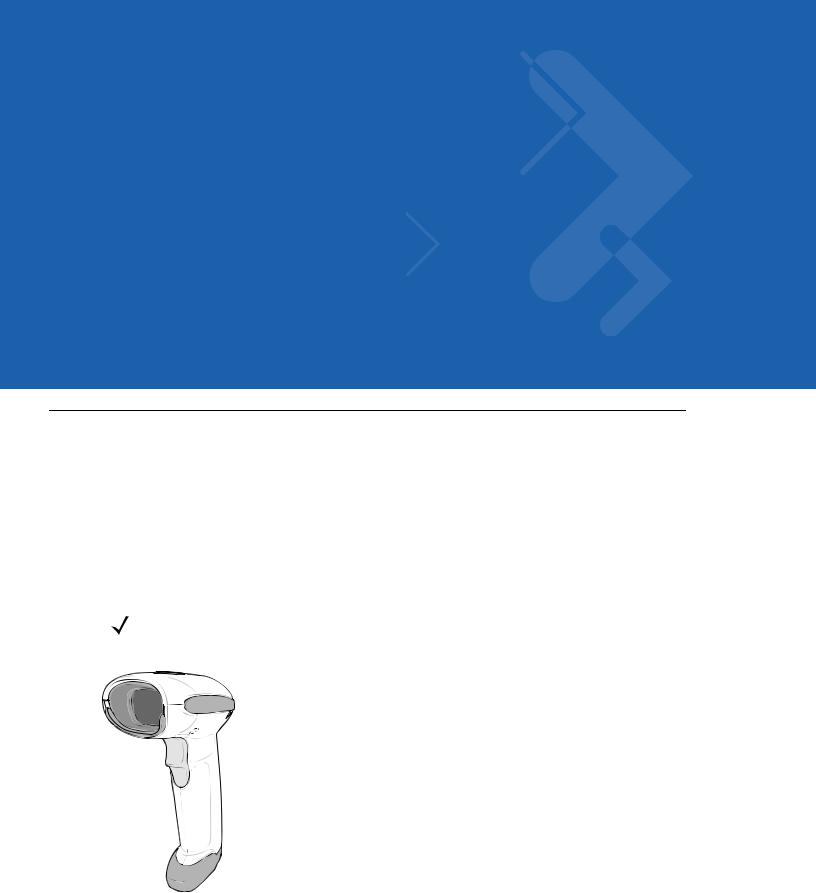
Chapter 1 Getting Started
Introduction
The scanner combines excellent scanning performance and advanced ergonomics to provide the best value in a lightweight laser scanner. Whether used as a hand-held scanner or in hands-free mode in a stand, the scanner ensures comfort and ease of use for extended periods of time.
In addition to single-line laser scanning, the scanner supports multi-line rastering. Multi-line rastering allows the scanner to capture stacked GS1 DataBar codes (formerly Reduced Space Symbology/RSS) and increases angular tolerances, minimizing product orientation and hand movements. Multi-line rastering also allows the scanner to read poor quality bar codes. For more information about scanning modes and stacked GS1 DataBar codes, see
Scan Pattern on page 4-6 and GS1 DataBar on page C-3.
NOTE Only the Symbol LS4208-PR version supports PDF417 bar codes and variants.
Figure 1-1 Symbol LS4208 Scanner

1 - 2 Symbol LS4208 Product Reference Guide
This scanner supports the following interfaces:
•Keyboard Wedge connection to a host. The host interprets scanned data as keystrokes. This interface
supports the following international keyboards (for Windows® environment): North America, German, French, French Canadian, Spanish, Italian, Swedish, UK English, Portuguese-Brazilian, and Japanese.
•Standard RS-232 connection to a host. Scan bar code menus to set up proper communication of the scanner with the host.
•USB connection to a host. The scanner autodetects a USB host and defaults to the HID keyboard interface type. Select other USB interface types by scanning programming bar code menus.This interface supports the following international keyboards (for Windows® environment): North America, German, French, French Canadian, Spanish, Italian, Swedish, UK English, Portuguese-Brazilian, and Japanese.
•Connection to IBM® 468X/469X hosts. Scan bar code menus to set up communication of the scanner with the IBM terminal.
•Wand Emulation connection to a host. The scanner is connected to a portable data terminal, a controller, or host which collects the data as wand data and decodes it.
•Scanner Emulation connection to a host. The scanner is connected to a portable data terminal, a controller which collects the data and interprets it for the host.
•Synapse capability which allows connection to a wide variety of host systems using a Synapse and Synapse adapter cable. The scanner autodetects the host.
•Configuration via 123Scan.
Unpacking
Remove the scanner from its packing and inspect it for damage. If the scanner was damaged in transit, contact Motorola Enterprise Mobility Support. See page xv for contact information. KEEP THE PACKING. It is the approved shipping container and should be used if the equipment ever needs to be return for servicing.
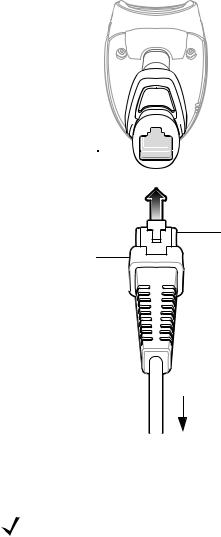
|
Getting Started |
1 - 3 |
|
|
|
|
|
|
|
|
|
Setting Up the Scanner
Installing the Interface Cable
To connect the interface cable:
1.Insert the interface cable’s modular connector clip into the cable interface port on the bottom of the scanner handle. (See Figure 1-2.).
2.Gently tug the cable to ensure the connector is properly secured.
3.Connect the other end of the interface cable to the host. (See the specific host chapter for information on host connections.)
Cable interface 
 port
port
|
Interface cable modular |
Interface cable |
connector clip |
|
|
modular connector |
|
To host
Figure 1-2 Installing the Cable
NOTE Different hosts require different cables. The connectors illustrated in each host chapter are examples only. Actual connectors may be different than those illustrated, but the steps to connect the scanner are the same.
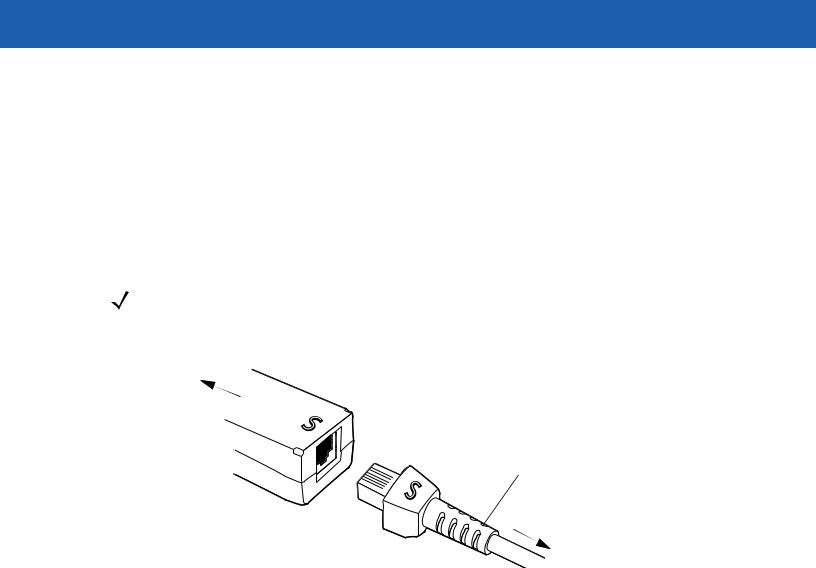
1 - 4 Symbol LS4208 Product Reference Guide
Removing the Interface Cable
To remove the interface cable:
1.Unplug the installed cable’s modular connector by depressing the connector clip with the tip of a screwdriver.
2.Carefully slide out the cable.
3.Follow the steps for Installing the Interface Cable on page 1-3 to connect a new cable.
Connecting a Synapse Cable Interface
NOTE Refer to the Synapse Interface Guide provided with the Synapse cable for detailed setup instructions.
Symbol’s Synapse Smart Cables enable interfacing to a variety of hosts. The appropriate Synapse cable has the built-in intelligence to detect the host to which it is connected.
To host
Synapse Adapter Cable
Synapse Smart Cable 
To Scanner
Figure 1-3 Synapse Cable Connection
1.Plug the Synapse adapter cable (p/n 25-32463-xx) into the bottom of the scanner, as described in Installing the Interface Cable on page 1-3.
2.Align the ‘S’ on the Synapse adapter cable with the ‘S’ on the Synapse Smart Cable and plug the cable in.
3.Connect the other end of the Synapse Smart Cable to the host.
Connecting Power (if required)
If the host does not provide power to the scanner, an external power connection to the scanner is required. To connect power:
1.Connect the interface cable to the bottom of the scanner, as described in Installing the Interface Cable on page 1-3.
2.Connect the other end of the interface cable to the host (refer to the host manual to locate the correct port).
3.Plug the power supply into the power jack on the interface cable. Plug the other end of the power supply into an AC outlet.
Getting Started |
1 - 5 |
|
|
Configuring the Scanner
To configure the scanner, use the bar codes included in this manual, or the 123Scan configuration program.
See Chapter 4, User Preferences, Chapter 12, Symbologies and Chapter 13, Miscellaneous Scanner Options for information about programming the scanner using bar code menus. Also see each host-specific chapter to set up a connection to a specific host type.
See Chapter 11, 123Scan to configure the scanner using this configuration program. A help file is available in the program.

1 - 6 Symbol LS4208 Product Reference Guide

Chapter 2 Scanning
Introduction
This chapter provides beeper and LED definitions, techniques involved in scanning bar codes, general instructions and tips about scanning, and decode zone diagram.
|
LED |
Scan |
|
Window |
Beeper |
|
Trigger
Figure 2-1 Parts

2 - 2 Symbol LS4208 Product Reference Guide
Beeper Definitions
The scanner issues different beep sequences and patterns to indicate status. Table 2-1 defines beep sequences that occur during both normal scanning and while programming the scanner.
Table 2-1 Beeper Definitions
Beeper Sequence |
Indication |
|
|
Standard Use |
|
|
|
Low/medium/high beeps |
Power up. |
|
|
Short high beeps |
A bar code symbol was decoded (if decode beeper is |
|
enabled). |
|
|
Clicking |
Occurs during PDF417 decoding to indicate proper |
|
alignment, motion, and distance. |
|
|
4 long low beeps |
A transmission error was detected in a scanned symbol. |
|
The data is ignored. This occurs if a unit is not properly |
|
configured. Check option setting. |
|
|
5 low beeps |
Conversion or format error. |
|
|
Low/high/low beeps |
Advanced Data Formatting (ADF) transmit error. See |
|
Chapter 14, Advanced Data Formatting. |
|
|
High/high/high/low beeps |
RS-232 receive error. |
|
|
Parameter Menu Scanning |
|
|
|
Short high beeps |
Correct entry scanned or correct menu sequence |
|
performed. |
|
|
Low/high beeps |
Input error, incorrect bar code or “Cancel” scanned, wrong |
|
entry, incorrect bar code programming sequence; remain in |
|
program mode. |
|
|
High/low beeps |
Keyboard parameter selected. Enter value using bar code |
|
keypad. |
|
|
High/low/high/low beeps |
Successful program exit with change in the parameter |
|
setting. |
|
|
Low/high/low/high beeps |
Out of host parameter storage space. Scan Default |
|
Parameters on page 4-3. |
|
|
Code 39 Buffering |
|
|
|
High/low beeps |
New Code 39 data was entered into the buffer. |
|
|
3 Beeps - long high beeps |
Code 39 buffer is full. |
|
|
Low/high/low beeps |
The Code 39 buffer was erased or there was an attempt to |
|
clear or transmit an empty buffer. |
|
|
Low/high beeps |
A successful transmission of buffered data. |
|
|

|
|
Scanning 2 - 3 |
|
|
|
|
|
|
Table 2-1 Beeper Definitions (Continued) |
|
|
|
|
|
|
|
Beeper Sequence |
Indication |
|
|
|
|
|
|
Host Specific |
|
|
|
|
|
|
|
USB only |
|
|
|
|
|
|
|
4 short high beeps |
Scanner has not completed initialization. Wait several |
|
|
|
seconds and scan again. |
|
|
|
|
|
|
Scanner gives a power-up beep after |
Communication with the bus must be established before the |
|
|
scanning a USB Device Type. |
scanner can operate at the highest power level. |
|
|
|
|
|
|
This power-up beep occurs more than once. |
The USB bus may put the scanner in a state where power to |
|
|
|
the scanner is cycled on and off more than once. This is |
|
|
|
normal and usually happens when the host cold boots. |
|
|
|
|
|
|
RS-232 only |
|
|
|
|
|
|
|
1 short high beep |
A <BEL> character is received and Beep on <BEL> is |
|
|
|
enabled. |
|
|
|
|
|
LED Definitions
In addition to beeper sequences, the scanner communicates with the user using a two-color LED display. Table 2-2 defines LED colors that display during scanning.
Table 2-2 Standard LED Definitions
LED |
Indication |
|
|
Off |
No power is applied to the scanner, or the scanner is on and ready to scan. |
|
|
Green |
A bar code was successfully decoded. |
|
|
Red |
A data transmission error or scanner malfunction occurred. |
|
|
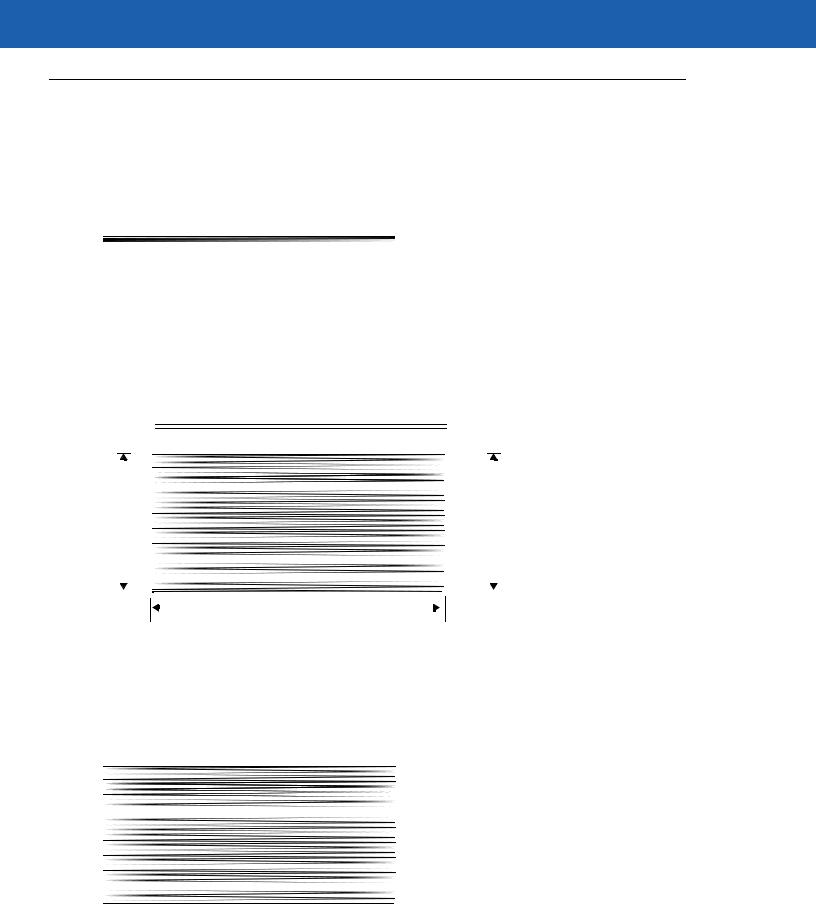
2 - 4 Symbol LS4208 Product Reference Guide
Scan Patterns
The scanner emits several scanning patterns, described as follows. To select a pattern, see Scan Pattern on page 4-6.
Single-Line Only
The laser has no up and down scan line movement (no raster).
Figure 2-2 Single-Line Only Scan Pattern
Multi-Line Smart Raster
The scan line begins as a single line and moves up and down (rasters) when a partial scan of a bar code is detected, or no bar code is decoded 500 ms after the trigger is pulled. If the scanner detects a PDF417
(Symbol LS4208-PR only), GS1 DataBar, or Composite Code, it immediately rasters, opening to a full, optimized raster pattern as soon as the scanner is properly aligned over the bar code.
Single Scan Line Pattern
Open Raster Pattern
Y-Axis |
|
|
|
|
Y-Axis |
|||
|
|
|
|
|
|
|
|
|
|
|
|
|
|
|
|
|
|
|
|
|
|
|
|
|
|
|
Horizontal Displacement (X - Axis)
Figure 2-3 Multi-Line Smart Raster Scan Pattern
Multi-line Always Raster
Rastering (up and down scan line movement) begins immediately to decode 1D, PDF417 (Symbol LS4208-PR only), GS1 DataBar, and Composite Codes.
Figure 2-4 Multi-Line Always Raster Scan Pattern

Scanning 2 - 5
Scanning Modes
The Symbol LS4208 accommodates both hand-held and hands-free modes. In hand-held use, you pull the trigger to activate the scan pattern and decode the bar code. In hands-free mode, the scanner sits in the Intellistand and automatically decodes a bar code presented in its field of view.
Scanning in Hand-Held Mode
Install and program the scanner (see Setting Up the Scanner on page 1-3). For assistance, contact Motorola Enterprise Mobility Support. See page xv for contact information.
To scan in hand-held mode:
1.Ensure all connections are secure. (See the host chapter for the scanner.)
2.Aim the scanner at the bar code.
3.Press the trigger.
Single-Line Mode |
Multi-Line Raster Mode |
Figure 2-5 Scanning in Hand-Held Mode
Upon successful decode, the scanner beeps and the LED turns green. For more information about beeper and LED definitions, see Table 2-1 and Table 2-2.
NOTE Scan line lengths vary depending on the scan line width selected (see Scan Line Width on page 4-7). A full scan line width is the default. Medium and short scan line widths are useful for scanning menus or pick-lists.
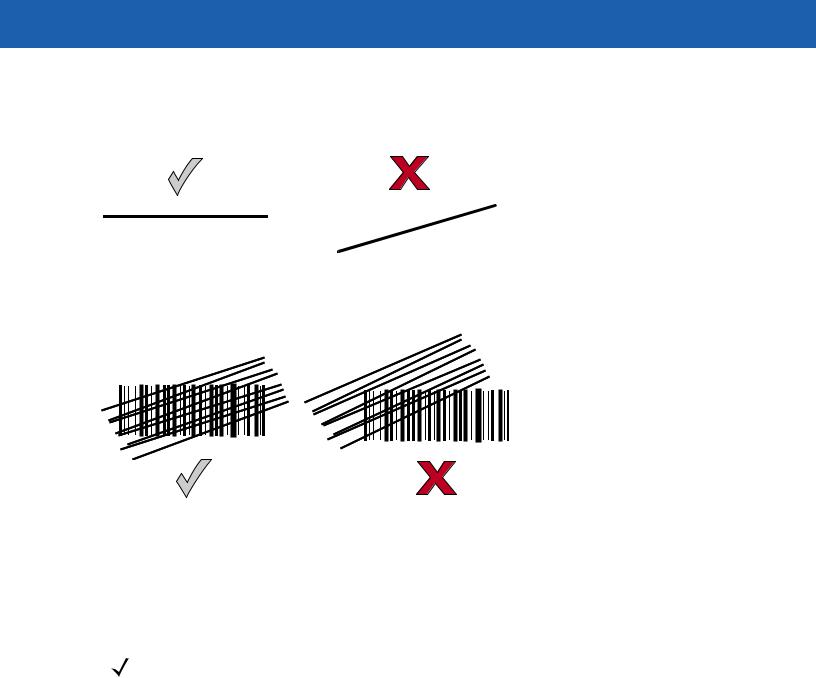
2 - 6 Symbol LS4208 Product Reference Guide
Aiming
On a typical UPC 100% hold the scanner between contact and 19 inches from the symbol (see Symbol LS4208 Decode Zone on page 2-11). When scanning using a single-line scan mode, ensure the scan line crosses every bar and space of the symbol.
012345
Figure 2-6 Acceptable and Incorrect Single-Line Aiming
When scanning using a multi-line raster mode, at least one scan line must cross every bar and space of the symbol.
012345 |
012345 |
|
Figure 2-7 Acceptable and Incorrect Multi-Line Aiming
Regardless of the scan mode, the scan line is smaller when the scanner is closer to the symbol and larger when it is farther from the symbol. Scan symbols with smaller bars or elements (mil size) closer to the scanner, and those with larger bars or elements (mil size) farther from the scanner.
Do not hold the scanner directly over the bar code. Laser light reflecting directly back into the scanner from the bar code is known as specular reflection. This specular reflection can make decoding difficult.
NOTE Scan line lengths vary depending on the scan line width selected (see Scan Line Width on page 4-7). A full scan line width is the default. Medium and short scan line widths are useful for scanning menus or pick-lists.
